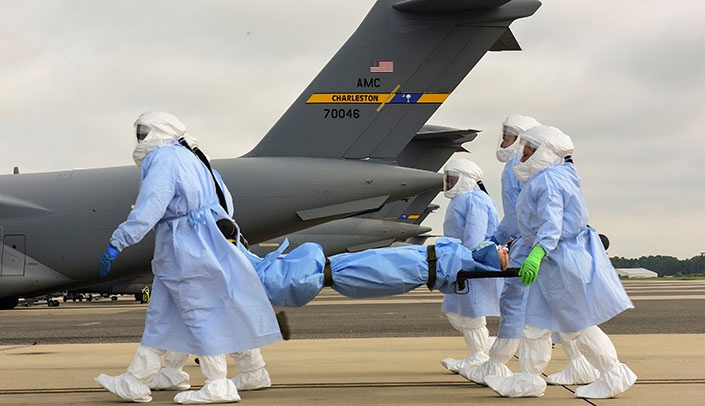UNMC’s biosecurity teams — working with the National Strategic Research Institute at the University of Nebraska (NSRI), Nebraska Medicine and Indiana University, Bloomington — have been busy this year conducting military research and training exercises for the Department of Defense and also providing training for civilian responders from across the nation.
John Lowe, Ph.D., assistant vice chancellor for interprofessional health security training and education at UNMC, has led a team of 11 investigators from Nebraska, Indiana and NSRI over the past 12 months evaluating the United States Air Mobility Command’s Transport Isolation System (TIS).
Funded by a $1.1 million contract from the Department of Defense, the team reviewed equipment and procedures used to airlift patients in isolation systems. Recently, during a flight from North Charleston, S.C., to Offutt Air Force Base, the team worked with the 628th Medical Group at Joint Base Charleston and the 375th Aeromedical Evacuation Squadron from Scott Air Force Base, Ill.
“UNMC and our partners are uniquely suited to conduct the complex systems-based research required by the U.S. Air Force to enhance infectious disease response,” Dr. Lowe said. “The Air Force’s commitment to building and maintaining infectious disease response aligns with UNMC’s mission to advance global health security.”
The TIS is an enclosure the Department of Defense designed to safely transport patients with highly contagious diseases and was engineered and implemented after the Ebola virus outbreak in 2014.
For the first time, the training used two TIS pods on one Boeing C-17 Globemaster III, a large military transport aircraft capable of rapid strategic delivery of troops and cargo. One system was used to quarantine a simulated highly infectious patient, while the other was used for monitoring and observation of two additional simulated patients who had been exposed to the infectious patient.
Joshua Santarpia, Ph.D., associate professor of pathology and microbiology and the research director for NSRI, said his team has been working to ensure the TIS system can contain infectious disease, both as designed and in operation.
“The mission to safely transport highly infectious patients is a complex one, involving not only flexible and robust engineering controls, like the TIS system, but also equally robust training and procedures. Our team works closely with Air Mobility Command to ensure that both aspects of this mission are ready to meet the country’s needs,” he said.
Dr. Lowe is on the executive council for the Global Center for Health Security at UNMC. The interdisciplinary council leads the development and coordination of health security training and education, clinical research and basic research. He also leads the coordination of existing health security training programs, including the National Ebola Training and Education Center, the National Center for Health Security and Biopreparedness and the Biosafety Infectious Disease Training Consortium.
Shawn Gibbs, Ph.D., who was the former associate dean for student affairs in the UNMC College of Public Health, was part of the original UNMC biocontainment team before becoming executive associate dean of public health at Indiana University.
“This unique partnership between the U.S. Air Force and its academic partners has the potential to help redefine capabilities for aeromedical evacuation of highly infectious patients,” he said.
“This program will add another and more robust tool for the U.S. Air Force to support Department of Defense assets as they respond to future needs associated with highly infectious disease outbreaks, while maintaining the safety of the crew members and our communities.”
Maj. Heather Cohen, Air Mobility Command deputy chief of medical modernization, said the University of Nebraska is considered to be the leading expert on containment of biological contamination in the United States.
“An exercise like this provides extremely important readiness training to our aeromedical airmen. The airmen were able to familiarize themselves with the various procedures and personal protective equipment required for this type of mission.
“We don’t know what the bug of the future might be,” Cohen said. “This is the next step in preparing for as many scenarios as possible.”
Editor’s note: This material is based upon work supported by the Air Mobility Command through the 55th Contracting Squadron under Contract No. FA4600-12-D-9000. Any opinions, findings and conclusions or recommendations expressed in this material are those of the author(s) and do not necessarily reflect the views of the 55th Contracting Squadron.

Very cool and love hazmat and chemical equipment for biohazards and research purposes!!